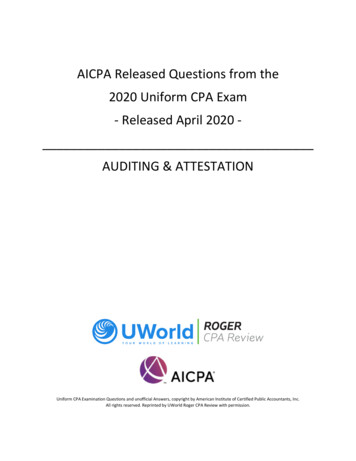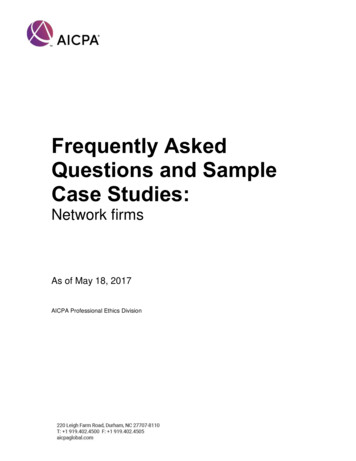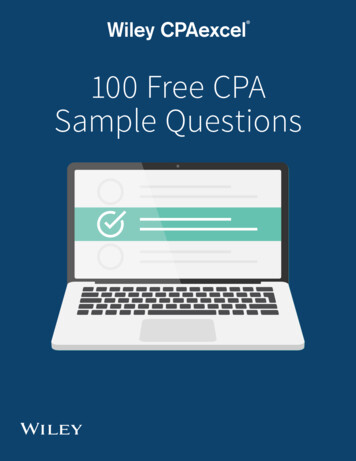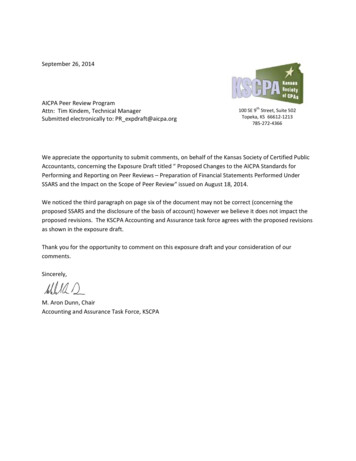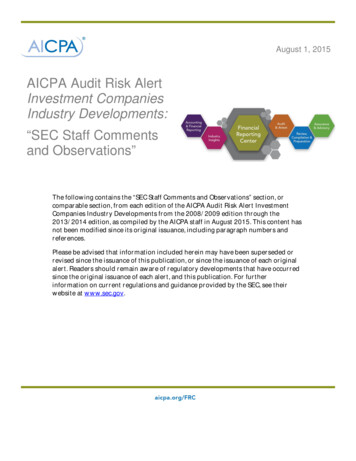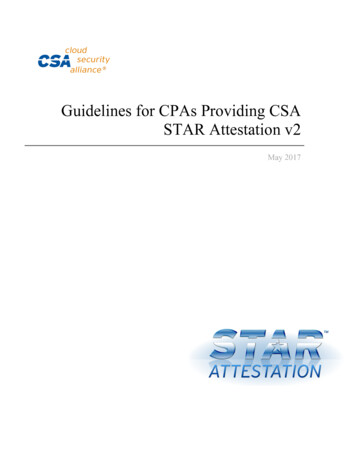
Transcription
UWorld Roger CPA Review2021 AICPA Released Questions – BECAICPA Released Questions from the2021 Uniform CPA Exam- Released April 2021BUSINESS ENVIRONMENT & CONCEPTSUniform CPA Examination Questions and unofficial Answers, copyright by American Institute of Certified Public Accountants, Inc.All rights reserved. Reprinted by UWorld Roger CPA Review with permission.
UWorld Roger CPA Review2021 AICPA Released Questions – BEC2021 AICPA Released Questions for BECThe Key gives the correct letter answer for each question.Key: AThe numbering system indicates the AICPA Blueprint Representative Task and Skill Level for each question.BEC.CSO.20190701: BEC.001.001.002BEC.SSO.20190701: Remembering and Understanding:1MULTIPLE CHOICE - MODERATEThe fraud triangle includes each of the following, onalization.Management, internal, and external auditors are responsible for detecting materialmisstatements due to error and fraud. Errors are unintentional mistakes, misjudgments, oromissions of amounts or disclosures. In contrast, fraud is an intentional act by one or moreparties involving the use of deception that results in a misstatement in the financial statements.Although management and auditors cannot be expected to detect all instances of fraud, theymust be able to recognize the conditions that are generally present when fraud occurs (referredto as the fraud triangle). These are: Incentive (motivation/pressure): the reason (eg, personal gain) the fraud was committed. Opportunity: the conditions (eg, weak controls) that allow fraud to occur. Rationalization: the perpetrator's justification for committing fraud.Collusion is a secret or illegal agreement between two or more people designed to cheat ordeceive others. For example, the inventory clerk in the accounting department and thewarehouse manager work together to steal inventory and cover up the theft.Item ID:35485Key: BBEC.CSO.20190701: BEC.001.001.002BEC.SSO.20190701: Remembering and Understanding:1
UWorld Roger CPA Review2021 AICPA Released Questions – BECAccording to COSO, which of the following issues should lead to the greatest concern regardingthe effectiveness of an entity's internal control?A.Monitoring internal control in areas that have never had a control failure.B.Errors from control failures that were not detected timely by the routine monitoringprocedures.C.Unwarranted duplication of efforts when multiple people monitor the same control.D.Additional evaluations solely to meet regulatory requirements when elements of otherprocedures would be sufficient.The COSO internal control framework is the most commonly used internal control (I/C)framework in the U.S. The framework consists of five components, one of which is monitoring.Monitoring encompasses two principles: Conduct ongoing and/or separate evaluations to determine if I/C components areoperating effectively.Evaluate and communicate I/C deficiencies to parties responsible (eg, board ofdirectors) for taking corrective action.The scope of monitoring would include all critical operating areas, even those that have neverhad an I/C failure. Although additional evaluations may need to be conducted to meetregulatory requirements, this is not the greatest concern regarding the effectiveness of I/C.Neither is any unwarranted duplication of monitoring efforts.Rather, it is that errors from control failures were not detected timely by the routinemonitoring procedures. In this instance, management would need to assess if additionalprocedures were required, or if the current procedures failed to perform as intended.Item ID:33683Key: BBEC.CSO.20190701: BEC.001.001.002BEC.SSO.20190701: Application:2
UWorld Roger CPA Review2021 AICPA Released Questions – BECA member of the audit committee is evaluating the following risk matrix for a company:Using statistical risk ranking methodology, which of the following lists of risks is .D.4,3,2,1.Statistical risk ranking is a risk management process which quantifies identified risk bymultiplying the likelihood of occurrence by the financial severity of the risk. The likelihood ofoccurrence depends upon the business industry.For example, the likelihood of a customer complaint in the restaurant segment might befrequent while in the transportation segment (ie, trucking) it might be rare. Severity isgenerally the dollar impact of the event.The correct prioritization of risk is 3, 4, 2, 1, determined by multiplying the severity times the likelihoodas verity 20,235169,477522,5312,937,632Item ID:81860Key: CBEC.CSO.20190701: BEC.001.002.002BEC.SSO.20190701: Application:2Risk(rounded) 1,68023,04939,19032,314Ranking4312
UWorld Roger CPA Review2021 AICPA Released Questions – BECAccording to the Sarbanes-Oxley Act of 2002, each of the following is a corporate responsibilityrequirement, except:A.The audit committee of the issuer is directly responsible for the appointment,compensation, and oversight of the registered accounting firm.B.The audit committee chairperson must certify that the quarterly report filed with theSEC fairly presents the financial condition and results of operations.C.The audit committee of the issuer must establish whistleblowing mechanisms andprocedures within the issuer.D.Each audit committee member of the issuer must be independent.The audit committee (A/C) consists of independent members of the board of directors.Independent members are not employed by the entity, are not shareholders, and are otherwiseunattached to the entity.An A/C member may receive compensation such as director fees, retainers, and meeting feesfor serving on the board and/or committees but may not: Accept any other consulting, advisory, or compensatory fee from the company. Be affiliated with the company.The A/C is responsible for overseeing the: Financial reporting process, making certain that reliable information useful tostakeholders is available on a timely basis. Appointment and compensation of the entity's auditors. Establishment of appropriate internal controls, including programs for the preventionand detection of fraud. Creation and publication of a code of ethics for senior financial officers. Establishment of a process for employees to anonymously report concerns (ie,whistleblowing) accounting matters and/or fraud. Engagement of independent counsel as deemed necessary.The CEO and CFO must certify that the quarterly report filed with the SEC fairly presents thefinancial condition and results of operations, not the audit committee.Item ID:35265Key: BBEC.CSO.20190701: BEC.001.003.000BEC.SSO.20190701: Remembering and Understanding:1
UWorld Roger CPA Review2021 AICPA Released Questions – BECA manufacturer performed an analysis of its product's price point in an effort to meet itscustomers' demand without experiencing excess inventory.The manufacturer uses just-in-time inventory processes, and demand for the product is elastic. Which ofthe following prices should management use in order to address the efforts above while maximizingprofits?A. 1B. 2C. 3D. 4The price point of a product is the hypothetical amount charged for each item. Generally, thelower the price, the greater the demand. The price point is determined after analyzing supplyand demand interaction.Just-in-time (JIT) is an inventory management system designed to prevent excess inventorybalances that increase nonvalue-added costs like storage and moving. JIT (ie, pull method) isbased on actual demand while traditional inventory management methods (ie, push method)are based on long-range forecasts of anticipated demand (ie, sales).This short-term focus allows JIT systems to maintain low inventory levels that are based on thenext few days of production. Theoretically, the perfect system would carry zero inventory onhand; daily deliveries would meet daily production requirements. In this scenario, a price pointof 3 sets inventory supply equal to demand, thus there are no costs to carry excess inventory.Item ID:503199Key: CBEC.CSO.20190701: BEC.002.002.000BEC.SSO.20190701: Application:2
UWorld Roger CPA Review2021 AICPA Released Questions – BECA company increased the price of its products and noted subsequent decreases in demand asbelow:The data above best support which of the following conclusions regarding the price elasticity ofdemand for the two products?A.Product A is treated by consumers as a necessity.B.Product B is treated by consumers as a luxury item.C.Substitutes are more readily available for Product A than for Product B.D.Substitutes are more readily available for Product B than for Product A.Barring shifts in the demand curve, a firm expects the quantity demanded for its product todecrease as the price increases, and vice versa. Whether total revenue will increase ordecrease when prices change depends on the price elasticity of demand (aka, “elasticity ofdemand”). This concept measures how responsive the quantity demanded is to a change inprice.The price elasticity of demand is the percentage change in quantity demanded divided by thepercentage change in price. One of the factors that affects the elasticity of demand is thenumber of available substitutes – more substitutes results in a more elastic demand since thebuyer has alternatives to choose from if the price were to change.Another factor is whether the product is a necessity or a luxury. If a good is necessary to have,the buyer will not be as sensitive to price changes, meaning that the demand will be less elasticfor necessities (ie, Product B). If a good is a luxury, it is not necessary to have it so the demandwill tend to be more elastic (ie, Product A).Here, the price elasticity of demand is -2 (-40%/20%) for Product A and -.67 (-20%/30%) forProduct B. Therefore, the demand for Product A is elastic; that is, the buyer is relativelysensitive to a change in the price. Demand for Product B is inelastic - the buyer is not verysensitive to a change in the price.Item ID:503197Key: CBEC.CSO.20190701: BEC.002.002.000BEC.SSO.20190701: Application:2
UWorld Roger CPA Review2021 AICPA Released Questions – BECTwo companies make handcrafted wooden ducks and rocking horses. Information about eachcompany's weekly production alternatives is as follows:Production possibilities are linear. The annual market for ducks in the relevant shipping rangeis saturated at 4,160 ducks. Treasure and Gem enter into a trade agreement. According to theprinciple of comparative advantage, which company should produce which product and why?A.Gem should produce horses because it only needs to sacrifice four ducks compared toTreasure's 10 ducks.B.Gem should produce ducks because it only needs to sacrifice two ducks compared toTreasure's four ducks.C.Treasure should produce horses because it only needs to sacrifice one-half of a horsecompared to Gem's one-fourth of a horse.D.Treasure should produce ducks because it only needs to sacrifice one-fourth of a horsecompared to Gem's one-half of a horse.Comparative advantage is an economic law that focuses on opportunity cost. It is generallyused to illustrate that protectionism is unnecessary in free trade. Here it is applied to twocompanies rather than two nations. In essence, it determines which entity/country is moreefficient (ie, more profitable) in the production of a given product or service.To calculate comparative advantage, first calculate the opportunity cost of each item.Opportunity cost is the profit sacrificed by choosing to make one product over another. Sinceprofit information is not provided here, the production relationship between ducks and horseswill provide the same information.For Treasure, the relationship between producing Ducks versus Horses is 60:15, or 4:1. ForGem, the relationship is 24:12, or 2:1. Treasure is more efficient in the production of duckssince it can produce 4 ducks for every 1 horse while Gem can only produce 2 ducks for every 1horse. Treasure should produce ducks because it only needs to sacrifice one-fourth of a horsecompared to Gem's one-half of a horse.Item ID:34709Key: DBEC.CSO.20190701: BEC.002.002.000BEC.SSO.20190701: Application:2
UWorld Roger CPA Review2021 AICPA Released Questions – BECGray Co. and Seas Co. have the following items on their balance sheet at the end of the currentyear:Which of the following statements best describes the liquidity position of the two companies inrelation to each other?A.Seas is more liquid because it carries a larger amount of current assets than Gray.B.Seas is more liquid because it has working capital greater than Gray.C.Gray is more liquid because it carries a smaller amount of current liabilities than Seas.D.Gray is more liquid because it has a larger current ratio than Seas.Businesses use liquidity measures to ensure they have sufficient financial resources to meetshort-term financial obligations. Two common measures of liquidity include the currentratio and working capital. The current ratio divides current assets (CAs) by current liabilities(CLs) whereas working capital subtracts CLs from CAs.Knowing the amount of working capital may be useful for internal management purposes but itis not useful for comparing liquidity between companies. The current ratio measures shortterm debt-paying ability as a percentage while working capital measures the ability to meetcurrent expenses in dollars. The current ratio is more useful since it can compare acrosscompanies and/or industries and show the relative strength or weakness of the company’sliquidity.The current ratio shows how many dollars in CA are available to pay every dollar of CL. In thisscenario, Gray has 2.50 in CA to pay every 1 in CL while Seas only has 1.67 in CA to pay each 1 in CL, as shown below:Current assetsCurrent liabilitiesGray Co. 2,500,000 1,000,000 1,500,0002.50Seas Co.5,000,0003,000,0002,000,0001.67ID:25575Key: DBEC.CSO.20190701: BEC.002.003.001BEC.SSO.20190701: Application:2Working capitalCurrent ratio
UWorld Roger CPA Review2021 AICPA Released Questions – BECBased on the following data, what is the cost of goods sold for the company?A. 200,000B. 400,000C. 600,000D. 900,000Certain costs are classified as product costs because they are incurred only when creating aproduct. Examples include raw materials, direct labor, and overhead, which includes indirectmanufacturing costs (eg, depreciation). Product costs are not expensed until the product issold. Other expenses not directly tied to the production process (eg, marketing andadministrative expenses) are classified as period costs and are expensed in the period they areincurred.Cost of goods manufactured (COGM) is the accumulation of product costs for goods that arecompleted (ie, manufactured) for a reporting period. Marketing and administrative expensesare period costs and therefore not included in COGM.COGM is used to determine cost of goods sold (COGS). COGM is given as 800,000. COGS is 400,000, calculated as follows:Beginning finished goodsPlus COGMGoods available for saleFinished goods endingCOGS 100,000800,000900,000(500,000) 400,000
UWorld Roger CPA ReviewItem ID:27035Key: BBEC.CSO.20190701: BEC.003.002.001BEC.SSO.20190701: Application:22021 AICPA Released Questions – BEC
UWorld Roger CPA Review2021 AICPA Released Questions – BECA company provides the following information about discount factors and yearly cash flows:If the discounted payback method is used, an outlay of 1,000 cash would most likely result inpayback in which of the following months?A.Month 33.B.Month 36.C.Month 42.D.After month 48.Businesses use capital budgeting techniques to select projects with the most potential forprofit. One technique is the payback period method, which estimates how long it will taketo recover the initial cost of a project. The payback period is the point at which the cumulativecash flows equal the cost.At the end of Year 3 (36 months), the PV of cumulative cash flows is 850. Another 150 isneeded to reach the initial cost amount of 1,000. That is 50% ( 150 / 300) of Year 4, or 6months. Therefore, payback will be reached at the end of month 42.Annualcash flowDiscountfactorPV of cash CumulativeflowPV 180 180Year 1 200.9Year 2400.8320500Year 3500.7350850Year 4500.63001150Item ID:25877Key: CBEC.CSO.20190701: BEC.003.003.000BEC.SSO.20190701: Application:2
UWorld Roger CPA Review2021 AICPA Released Questions – BECWhich of the following individuals or groups within an organization reviews and approves longrange plans and oversees its information systems?A.Systems steering committee.B.Project development team.C.Systems analyst.D.Database administrator.In order to tailor IT governance to a business, the board of directors and management rely oncommittees, particularly the IT Steering Committee, to provide oversight, prioritize stakeholderrequests, set policy, and monitor IT activities.The IT Steering Committee consists of management-level employees. Their responsibilitiesinclude: Prioritizing IT projects (short and long-range) and allocating IT resources.Overseeing information systems and communicating control and risk information.Evaluating IT performance.A systems analyst, project development team members, and/or database administrator wouldnot individually approve long-range plans or perform high-level monitoring of IT projects.Item ID:40201Key: ABEC.CSO.20190701: BEC.004.001.001BEC.SSO.20190701: Remembering and Understanding:1
UWorld Roger CPA Review2021 AICPA Released Questions – BECA credit card company that processes millions of transactions each year has experienced anincrease in fraudulent transactions. The company maintains a data warehouse with data aboutcustomers and transactions from the past five years. How could the company best use this datato detect potentially fraudulent charges within 24 hours of receipt of transaction data?A.Employ data mining.B.Increase the internal audit staff.C.Adopt more stringent credit-approval policies.D.Use sequential coding for authorization numbers.Data mining (also called data mining as data discovery, knowledge discovery, or discoveryanalysis) is essentially the foundation of data analytics. It involves looking for patterns, trends,relationships (associations) or anomalies within a data set. As such, it can be useful in detectingfraudulent charges based on past transactional behavior.Increasing the internal audit staff will not be sufficient to examine millions of transactions andwould be less efficient than use data mining. Adopting more stringent credit-approval policiesmay reduce credit losses but will not reduce fraudulent transactions, particularly since fraudcould be committed by internal parties.Sequential coding (also called serial coding) labels numbers in a consecutive order. If fraud iscommitted within an otherwise legitimate transaction (eg, credit card theft), sequential codingwill not detect this. If a fraudulent transaction occurs in a field other than an authorizationnumber (eg, a transaction amount), sequential coding will not appropriately detect thistransaction.Item ID:25539Key: ABEC.CSO.20190701: BEC.004.001.003BEC.SSO.20190701: Application:2
UWorld Roger CPA Review2021 AICPA Released Questions – BECA company's time-based model of security gathers the following data:The estimated time for an intruder to penetrate the system is 27 minutes. Which of thefollowing conclusions is appropriate?A.The security policy is ineffective under all of the best-case scenarios.B.The security policy is effective under the best-case detection time scenario coupled withthe worst-case correction time scenario.C.The security policy is effective under the worst-case detection time scenario coupledwith the best-case correction time scenario.D.The security policy is effective under all of the worst-case scenarios.Time-based security (TBS) is a methodology used to measure and quantify the effectiveness ofa given level of security, including the cost of accepted vulnerabilities (eg, blind spots, gaps inprotection, etc). Management can then decide and budget for the preventive and detectivemeasures it decides are cost-beneficial.The formula for TBS is P(t) D(t) R(t), where:P the time to break controlsD the time to detect the attack and notify securityR the time to respond correct any damage from the attackThere are four scenarios for determining total TBS using best (B) case and worst (W) casedetection (D) and response (R) information:BD BR 8 14 22 minutesBD WR 8 18 26 minutesWD BR 14 14 28 minutesWD WR 14 18 32 minutes
UWorld Roger CPA Review2021 AICPA Released Questions – BECClearly the most favorable TBS is the best case scenario for detection and response actions of22 minutes. However, that is not an answer option. The next best scenario of 26 minutes isbest case detection and worst case response times. The remaining two options exceed 27minutes and are not effective.Item ID:35839Key: BBEC.CSO.20190701: BEC.004.003.003BEC.SSO.20190701: Application:2
UWorld Roger CPA Review2021 AICPA Released Questions – BECMultiCo has the following sales mix:What amount is MultiCo's weighted average contribution margin per unit?A. 40.00B. 49.50C. 56.67D. 63.33Contribution margin (CM) equals unit sales price less unit variable cost (VC). It represents theamount per unit of sales revenue that is not consumed by VC, and so it contributes to coveringfixed costs. Fixed cost is not part of calculating CM.Weighted average contribution margin (WACM) represents the average CM of a group ofproducts. WACM can be determined by multiplying the individual CM per unit by its percent ofunits sold, as shown below:ProductShoesSwimsuitsHatsTotalSalesprice 1005040Variable Contributioncostsmargin (CM) 25 751040535Percentunits sold30%50%20%Weightedaverage CM 22.5020.007.00 49.50If the number of units is known, WACM can also be calculated by dividing total CM by totalunits sold.Item ID:39599Key: BBEC.CSO.20190701: BEC.005.002.001BEC.SSO.20190701: Application:2
UWorld Roger CPA Review2021 AICPA Released Questions – BECEstimated sales for the Johnson Co. in the second quarter are shown below by month:Johnson has a policy of maintaining 40% of the following month's estimated cost of sales onhand in merchandise inventory at the end of each month. The cost of goods sold is 60% ofsales. What is the cost of the merchandise inventory that Johnson needs to purchase in May?A. 21,600B. 24,000C. 26,400D. 44,000To assist management in strategic planning, companies use a master budget to help establishfinancial and production goals. The master budget consists of many smaller budgets, includinga purchasing budget. This budget details the amount and timing of merchandise inventorypurchases needed to meet sales requirements.The first step is to define all requirements consistently. Remember that the cost of goods sold(COGS) is a percentage of the sales amount. Here, COGS is 60% of predicted sales for a givenmonth. The cost of inventory needed for May’s sales of 40,000 would therefore be 24,000(60% 40,000).It is also important to remember that beginning inventory for one month equals endinginventory for the prior month (eg, beginning inventory for May is equal to ending inventory forApril). Finally, ending inventory is 40% of the COGS for the next month.The cost of inventory that Johnson needs to purchase in May is 26,400, calculated as follows:Inventory needed for May sales60% of May’s sales 24,000Plus desired ending inventory40% of June’s COGS12,000Less beginning inventory for May40% of May’s COGS9,600Cost of purchases for MayItem ID:25735Key: CBEC.CSO.20190701: BEC.005.004.001BEC.SSO.20190701: Application:2 26,400
UWorld Roger CPA Review2021 AICPA Released Questions – BECA company has determined that its sales to residential home builders tend to vary with changesin the prime interest rate. Sales this year will be 5 million. The following information isavailable:What amount is the expected value of the company's sales for the coming year's budget?A. 5,037,500B. 5,150,000C. 5,172,500D. 5,337,500COSO's Enterprise Risk Management (ERM) framework addresses multiple aspects of risk,including prioritizing risk and assessing the severity of that risk. The primary factor inprioritizing risk is calculating the expected value.To find the expected value (ie, weighted average), multiply each possible outcome by itslikelihood (or probability) and sum the amounts. The first step is to determine the projectedsales amount, given the growth rate and current year sales of 5,000,000.Projected sales are then multiplied by the probability to determine the expected value for thatlevel of sales growth. Total expected value is 5,037,500, calculated as follows:Prime interest rate ProbabilityIncreases 2%15%Increases 1%40%Unchanged35%Decreases 1%10%Expected valueSales growth Projected Sales(20%) 4,000,0003%5,150,0005%5,250,0008%5,400,000Item ID:29663Key: ABEC.CSO.20190701: BEC.005.004.002BEC.SSO.20190701: Application:2Expected value 600,0002,060,0001,837,500540,000 5,037,500
UWorld Roger CPA Review2021 AICPA Released Questions – BECMULTIPLE CHOICE - HARDA company has established and communicated baseline expectations for performance to allemployees. The company's action demonstrates a focus on which of the following componentsof the COSO Internal Control Framework?A.Control activities.B.Monitoring activities.C.Control environment.D.Information and communication.COSO defines internal control (I/C) as a process developed to provide reasonable assurancethat the objectives related to operations, reporting, and compliance are achieved. To assistentities in this process, COSO created the internal control framework, which consists of fivecomponents.One component, the control environment, is a combination of standards, processes, andstructures that enable I/C to be effective throughout an organization. COSO indicates that thisis the most significant component when it comes to communicating baseline expectationsabout an entity's attitude toward competence and accountability (eg, job performance),integrity, and ethics.Control activities are the policies and procedures that management designs and implementsto address risks. Monitoring refers to the processes an entity uses to determine if all five ofthe I/C components are in place and are functioning in the manner intended. Informationand communication relates to how the entity obtains and develops information and how theinformation is disseminated.Item ID:86779Key: CBEC.CSO.20190701: BEC.001.001.002BEC.SSO.20190701: Remembering and Understanding:1
UWorld Roger CPA Review2021 AICPA Released Questions – BECA threat to an information system with a total potential dollar loss impact of 7 million hasbeen discovered. The risk of loss to the identified threat is currently 10%. The following fourproposed controls are under consideration to mitigate the risk of loss:Based on a cost-benefit analysis, which control provides the greatest net benefit?A.Control W.B.Control X.C.Control Y.D.Control Z.Successful entities know how to identify and manage risk. Risk assessment refers to an entity'srecognition that events may occur that pose risks to its objectives and the process of identifyingand evaluating those risks.The primary factor in prioritizing risk is calculating the expected value. Expected value assignsprobabilities to identified risks and combines the likelihood and amount of all the risks into asingle value. Here, Control Y provides the greatest net benefit of 840, as shown below:Item ID:92762Key: CBEC.CSO.20190701: BEC.001.002.002BEC.SSO.20190701: Application:2
UWorld Roger CPA Review2021 AICPA Released Questions – BECWhen risk is evaluated, which of the following risk responses is generally considered a sharingresponse?A.Diversifying product offerings.B.Entering into syndication agreements.C.Reallocating capital among operating units.D.Rebalancing the asset portfolio to reduce exposure to certain types of losses.Identified risks must be prioritized to develop risk responses. Alternative risk responsesinclude risk acceptance, sharing, reducing (or mitigating), and avoidance. Appropriateresponses are based on the amount of potential damage (financial and nonfinancial) and rate ofoccurrence.Risk acceptance occurs when the entity takes no action and simply allows the event to occur.This occurs when the entity believes the risk is at an acceptable level or that the cost of takingaction would exceed the benefit of the reduction.Risk sharing occurs when the risk burden is partially or wholly distributed to other externalparties. For example, obtaining insurance coverage or entering into a syndication agreement.Risk reduction can include changing the operating environment (eg, diversifying productofferings) or rebalancing an asset portfolio to reduce exposure to certain types of losses.Reallocating capital among operating units simply shifts the risk internally; it does not reducethe aggregate risk.When none of the above alternatives is an option, risk avoidance may be the best alternative.For example, the entity may need to eliminate a line of business, stop using a particular rawmaterial, or buying from a specific supplier.Item ID:32793Key: BBEC.CSO.20190701: BEC.001.002.002BEC.SSO.20190701: Remembering and Understanding:1
UWorld Roger CPA Review2021 AICPA Released Questions – BECAccording to the Sarbanes-Oxley Act of 2002, the audit committee of an issuer is responsible foreach of the following activities, exceptA.Evaluating and reporting on the effectiveness of the company's internal control overfinancial reporting.B.Preapproving all audit and nonaudit services provided by the company's auditor.C.Establishing procedures for the receipt, retention, and treatment of complaints receivedby the company regarding accounting, internal control, and auditing matters.D.The
UWorld Roger CPA Review 2021 AICPA Released Questions - BEC 2021 AICPA Released Questions for BEC The Key gives the correct letter answer for each question. Key: A The numbering system indicates the AICPA Blueprint Representative Task and Skill Level for each question. BEC.CSO.20190701: BEC.001.001.002


